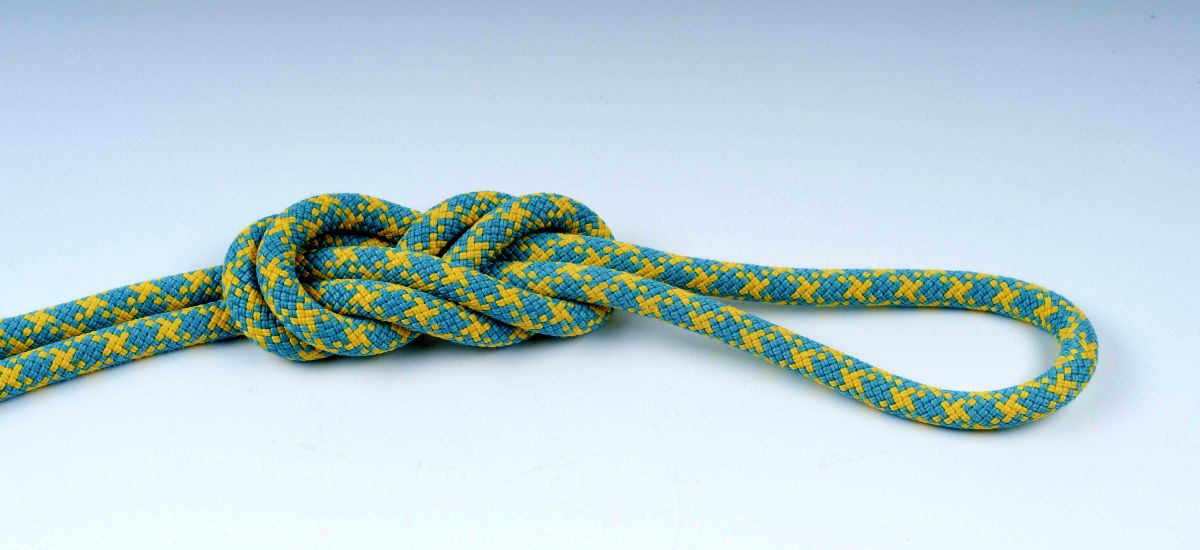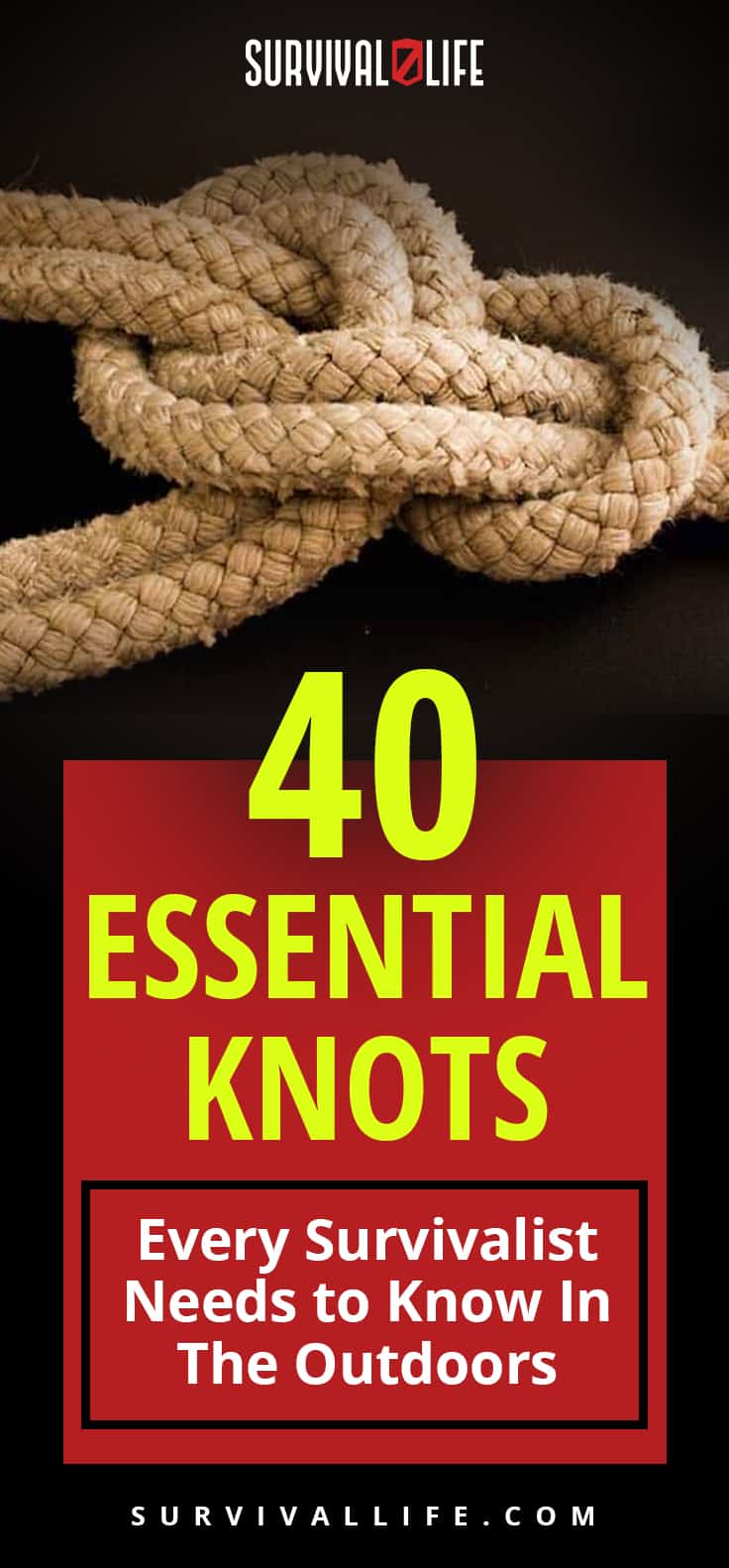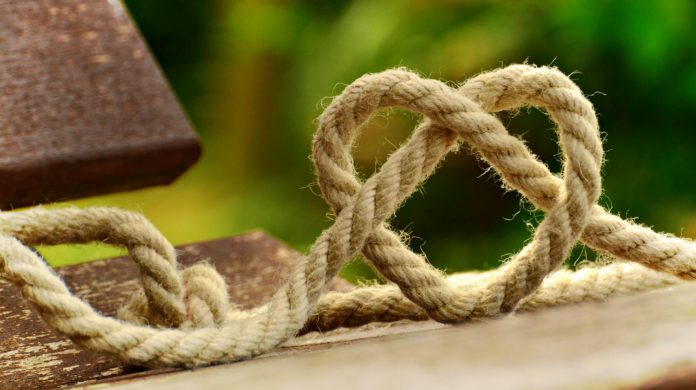These are some amazing and useful knots. Learn to time these knots and you will find them useful throughout your life. Teach them to your children!
RELATED: How to Tie the Best Knots for Camping and Survival
Essential Knots: How Many of These Can You Tie? 1. Overhand Knot
The overhand knot is one of the basic knots. In fact, you can use this as the basis of all the other essential knots you will make.
You can also tie other knots with this fundamental knot. Indeed, when making paracord hitches, you will see the overhand knots along with other knots.
2. Double Overhand

If you know the overhand knot, this is the extended version of it. But there’s just one additional pass that makes it different to the overhand knot, it’s also bigger and a bit harder to untie.
3. Figure Eight Knot

This is one kind of stopper knot and it is also useful when rock climbing and sailing. The purpose of this knot is to prevent ropes to run out from retaining devices. It’s also easier to get this kind of knot undone as compared to the overhand knot.
4. Running Knot
Those into crochet and knitting know the running knot since it’s the starting point. It’s an adjustable knot related to the slip, noose, and slipped overhand knot.
It also tightens once you pull the rope and also undone easily by pulling on the working end. You can also use it as a stopper knot.
5. Granny Knot
You can use this knot a.k.a, the binding knot to secure an object using a line or a rope. Though it resembles the square knot or reef knot, it’s still inferior to it when it comes to uses.
6. Sheepshank
This is a type of knot you can use to shorten a rope temporarily. Do consider that this type of knot is unstable. If you place a little too heavy or too light load, it will fall apart.
7. Square Knot
You can also call this as the reef knot. To make this type of knot, just tie an overhand knot (left-handed) to another overhand knot (right-handed). You can use this as a binding knot with the right material on a curved surface.
8. Bowline Knot
This is one type of knot which you can tie and untie easily. You can make this by forming at the end of the line a fixed circle or loop.
While it’s a simple knot, it’s ancient too, which stood the test of time. It’s also one of the basic four maritime essential knots, including the figure eight knot, clove hitch, and reef knot.
9. Sheet Bend Double
This is a sheet bend knot doubled and effective to secure different lines. It has a tendency to loosen if not loaded though. This is almost similar to a bowline and a more secure alternative to the square knot.
10. Sheet Bend
You can make a sheet bend knot by joining two ropes. This is also called as weaver’s knot or weaver’s hitch. One way to tie this knot is by creating a half hitch in the slack part of a larger rope.
11. Overhand Bow

You can use this type of knot for fishing, shoelaces, climbing, as well as joining other knots. It is difficult to untie though but quite strong and reliable.
12. Double Carrick Bend
This type of knot is appropriate when using a rope that is heavy, very large, or too stiff. You won’t need to worry about the knot jamming while lifting a heavy load.
13. Bow Knot
A bow knot has large loops that are decorative. It consists of two loops and two ends that are loose. This knot is commonly used to tie shoelaces and you can easily tie and untie it.
14. Figure Eight Double
You can also call this type of knot as “bunny ears” or dog-eared loop. You can make this by forming two parallel loops similar to a figure-eight loop.
15. Clove Hitch Knot
The Clove Hitch#clove #hitch #knot #knots #allaboutyachts #yachts #sailing * The Clove Hitch is another indispensable knot for the yachtsman.* It is extremely simple to use and extremely important in the application.* The most popular application on … https://t.co/FFnaTehrbQ pic.twitter.com/7YQ36tOGgU
— All About Yachts (@AllAboutYachts2) March 4, 2019
You can make this type of knot through two successive hitches half tied to an object. This is considered one of the most essential knots and commonly called a double hitch. It’s also most effective if you use it as a crossing knot.
16. Half Hitch
The half hitch knot is a simple knot done overhand. You can make this by bringing one end of the rope over and underneath the standing edge. This is not a secure knot, but it is essential when making bends and other knots.
17. Timber Hitch
This is also another type of knot you can use to attach one rope to an object that is cylindrical in shape. With this knot, you only use a single length of rope. You can easily untie this even after loading a heavy object.
18. Killick Hitch
If you are planning to hitch a knot to an object of odd shapes, this the perfect knot to use. It is also called as the kelleg hitch. A combination of a half hitch and a timber hitch, you can also use this knot when pulling or lifting an object.
19. Halyard Bend
Gaff Topsail Halyard Bend, actually a hitch used in boating to attach a rope to a pole | Day 54 #Scout series #knots #vsco https://t.co/lv28tAxLKE pic.twitter.com/vuKUmRvaOt
— Jessel Sookha (@jsookha) January 31, 2018
This type of knot is used to attach the end of a line or rope to any object that is cylindrical in shape. You need to tie it at a right angle though. This is another version of timber hitch doing a double loop around and single tuck underneath.
20. Rolling Hitch
You can use this knot when tying it to another rope, a pole, or any rod. This type of knot resists any kind of movement lengthwise with a single pull. This is commonly used when sailing as a stopper when relaxing any tension over a sheet clearing any blockage.
RELATED: How To Build An Urban Survival Kit
21. Fisherman’s Bend
The fisherman’s bend has two double overhand knots tied to each other on every end. The line you can make with this is also called as the Prusik Knot, which is excellent as ropes for climbing.
What is the Prusik knot? This is a friction knot typically used when ascending or descending on a rope like canyoneering, zip lining, climbing, caving, or rope rescue. The knot is attached to a loop of cord positioned around the rope.
22. Two Half Hitches

This type of knot can be a hitch knot or a binding knot. You may do this by creating an overhand knot which you tie to a post. You can then create a half hitch from there. It’s also called a double half-hitch.
23. Hitching Tie
This is the perfect knot to use when tying off stuff sacks. You can easily untie it, and it’s a simple knot to make as well.
It is also a slip knot or a noose wherein the loop is tied tight around the object. You cannot use this though as a strong knot when doing extreme activities.
24. Tiller’s Hitch
A Tiller’s hitch is a good knot for holding. This is suitable for holding the tiller and yet easily unties. This is also the loose version of a sheet bend, and you may use this in instances wherein you need to release quickly.
25. Cat’s Paw
This is another type of knot used to connect a rope to an object. You can find this knot as similar to a cow hitch. The only exception is the additional twist on every side of the slack part of the rope. This way, it is less likely to slip.
26. Blackwall Hitch
You can use this type of knot if you want to temporarily attach a rope to a hook. It consists of a half hitch and will hold when there is constant tension.
You can only use this when the hook and the rope are equal in size. But, it will slip when there is stronger tension on the rope.
27. Midshipman’s Hitch
Midshipman’s Hitch https://t.co/cwkhfu6h8Z pic.twitter.com/3KWIOvvEKz
— Jack Raven Bushcraft (@JackRavenInfo) March 4, 2019
This knot is another option to loosen any lines that are under tension. It is an adjustable loop, which you can use for lighter applications. An example where you can use this knot is when setting up a tent.
28. Lark’s Head
A lark’s head is also a temporary knot that is loose. You can also use this on a rod or a pole. It’s also considered as one of the decorative knots frequently used. This is one type of a hitch knot used for processes that involve mounting.
29. Sailor’s Knot
This is a secure hitch which is also jam-proof. You can use this to fit the rope to any object that it’s attached to.
It is also another type of the Josephine knot. You use two loops with this knot instead of three which makes it different from the Josephine knot.
30. Miller’s Knot
The Miller’s knot is also called as the “sack knot” or “bag knot.” You can use this to secure any openings such as in a bag or a sack. This is basically used for binding and it’s historically associated with tying of sack of grains thus, the “miller” name.
31. Marlinspike Hitch
You can use this temporary knot if you want to attach a rope to a rod in the form of a handle. You can also use this knot for other rope work. This knot allows for added tension on the rope compared if gripping only with bare hands.
32. Fisherman’s Knot

You can also call this the “halibut knot.” It’s a kind of bend consisting of two overhand knots to form a symmetrical angle. You can also use the fisherman’s knot to join thin, slippery, or stiff lines.
33. Surgeon’s Knot
You can use this type of knot to bind and surgeons use this often. It keeps tension over a suture, thus its name. It’s also considered as one of the easiest essential knots to tie when combining lines equal or unequal in diameters.
34. Fisherman’s Eye
This is also called the True Lover’s Knot. Anglers make use of this to create a leader loop. This is a very useful loop which you tie on the loose end of a rope using 1 of 4 other methods.
35. Slippery Hitch
Need an #easy #knot for #dog‘s #leash?#Quick 30sec #lesson on how to tie a Slippery #Hitchhttps://t.co/ETyJOHEu9N pic.twitter.com/brZew8zcZu
— Repairs101 (@Repairs101) June 8, 2016
If you want to tie a knot to a rod or a bar, the slippery hitch is a good choice. However, it cannot provide you with reliable strength compared with other knots. You can easily untie and tie it though.
36. Stevedore’s Knot
You can use this knot as a stopper knot. It is usually tied to the end of the rope and where the lariat’s other end can pass through to make a running noose. This knot is bulkier though but less likely to jam compared to the figure-eight knot.
37. Lariat Loop
This is a type of a circular small loop. It is also tied to one end of the lariat through a knot.
Cowboys often make this loop when they need to lasso a horse or a cattle. It is circular in shape which loosens freely especially with a stiff rope where you tie it with.
38. Bowline on Bight
Knot of the Day: Bowline on a BightThe Bowline on a Bight makes a secure loop in the middle of a piece of rope. It does not slip or bind. #knots #KnowYourKnotshttps://t.co/hOsBbwC8fU pic.twitter.com/LYrPDut9Ch
— Animated Knots (@animatedknots) January 20, 2019
You can make this type of knot by making a pair of loops with fixed sizes. You can also easily untie this knot after a strain. This is a secure loop which you can use for slings or as an improvised seat during an emergency.
39. Taut-line Hitch
With this knot, you can adjust it to suit lines that are under tension. This type of knot comes in handy when you need to adjust the length of a line from time to time. You can also use this as an alternative when securing your tent ropes or when climbing a tree.
40. Chain Hitch
You can use this type of knot when connecting a rope to an object that is cylindrical in shape. This is the same as a marline hitch. You can also achieve this knot by forming successive essential knots in the style of a clove hitch.
This post on essential knots is based on the infographic courtesy of Wide Open Spaces.
Whether you’re prepping for the unknown or just a weekend camping trip, learn how to tie knots first for your own good. But knowing the different types of knots and their uses, especially these essential knots will give you the upper hand.
Which among the essential knots listed have you tried so far? Do share your experience in the comments section below.
Up Next:
12 Unique Ways Shoe Laces Could Save Your Life Tie it All Together with These 9 Survival Knots How To Make Rope Out Of The Yucca Plant
Follow us on Facebook, Instagram, Twitter, Tumblr, and Pinterest!
Disclaimer: The contents of this article are for informational purposes only. Please read our full disclaimer.
The amazing MicroFish Survival Kit is ultra light and made with paracord. Grab yours for FREE.

Editor’s Note: This post was originally published on April 4, 2018, and has been updated for quality and relevancy.
Read more: survivallife.com






